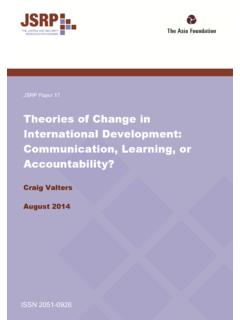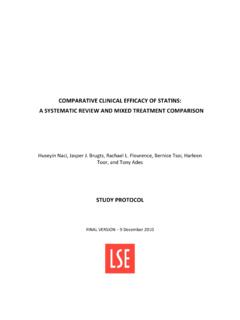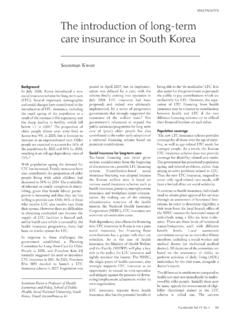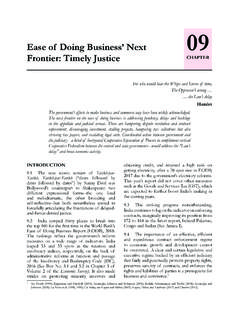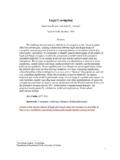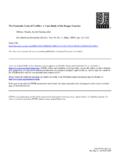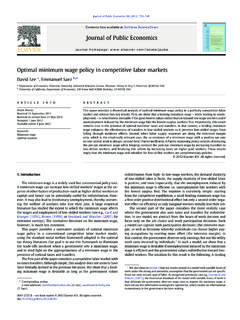Transcription of Why Nations Fail: The Origins of Power, Prosperity and Poverty
1 Why Nations fail : The Origins of Power, Prosperity andPovertyMorishima Lecture, LSE June 8, 2011 James A robinson (with Daron Acemoglu)HarvardJune 6, 2011 Acemoglu robinson (Harvard)Why Nations FailJune 6, 20111 / 36 IntroductionThe Lay of the LandFigure:The evolution of average GDP per capita in Western O shoots, WesternEurope, Latin America, Asia and Africa, robinson (Harvard)Why Nations FailJune 6, 20112 / 36 The BeginningThe Beginning Latin AmericaJuan D az de Sol s explores R o de la Plata ( River of Silver ) in 1516,and Pedro de Mendoza founds Buenos Aires in Sol s and de Mendoza unable to enslave and put to work thehunter gatherer Indians of the area, Charr as and the Querand .Starving Spaniards soon left the 1537, Juan de Ayolas found the sedentary and more densely settledGuaran up the Paran river, in Paraguay. The Spaniards couldsuccessfully take over the Guaran hierarchy, enslave them and putthem to work to produce food for very similar pattern to the colonization of the Aztecs and the robinson (Harvard)Why Nations FailJune 6, 20113 / 36 The BeginningThe Beginning United StatesColonization attempts of Virginia Company in Jamestown in early17th century, attempting to re-create an authoritarian, extractive regime: No man or woman shall run away from the colony to theIndians, upon pain of who robs a garden, public or private, or a vineyard, orwho steals ears of corn shall be punished with member of the colony will sell or give any commodity ofthis country to a captain, mariner, master or sailor to transportout of the colony, for his own private uses, upon pain of death.
2 [from the laws passed by Sir Thomas Gates and Sir ThomasDale].But the Company was unsuccessful it could not force the Englishsettlers into gang labor and low robinson (Harvard)Why Nations FailJune 6, 20114 / 36 The BeginningThe Beginning United States (continued)The Company switched to the headright system giving all settlers 50acres of land and then shortly thereafter also political rights, in theform of it General Assembly in events unfolded in Pennsylvania, Maryland and the chain of events that ultimately leading to the Declaration ofIndependence and the di erences in the ways Latin America and North America wereorganized historically explain the di erences in the ways they areorganized today and their di erent levels of robinson (Harvard)Why Nations FailJune 6, 20115 / 36 The BeginningLegacy of Colonial Times TodayE ects today of theMitathe largest system of forced labor in colonialLatin America (fromDell (2010))
3 Persistent E ects of Peru s MiningMita )Acemoglu robinson (Harvard)Why Nations FailJune 6, 20116 / 36 The BeginningMaking Sense of the DivergenceWhile both culture (religion, attitudes, values) and geography(climate, topography, disease environments etc.) are important forthe ability of humans to form well functioning societies, they are notthe main source of this of Latin America likely richer than North America as late asmid-18th due to the ability of the United States, just like Britain, totake advantage of new economic ignorance hypothesis also unable to explain the logic of socialarrangements leading to relative Poverty Cortes, Pizarro and Ayolasdid not set up forced labor and repressive regimes because they were ignorant about their , central role of institutions broadly de ned as the rules thatgovern economic and political questions:historical roots of institutional di erences and thelogic of institutions that do not unleash robinson (Harvard)Why Nations FailJune 6, 20117 / 36 Main ConceptsInclusive and Extractive InstitutionsTowards a Theory of InstitutionsExtractive economic institutions.
4 Lack of law and order. Insecureproperty rights; entry barriers and regulations preventing functioningof markets and creating a nonlevel playing political institutions in the limit absolutism :Political institutions concentrating power in the hands of a few,without constraints, checks and balances or rule of law .Inclusive economic institutions:Secure property rights, law andorder, markets and state support (public services and regulation) formarkets; open to relatively free entry of new businesses; upholdcontracts; access to education and opportunity for the great majorityof political institutions:Political institutions allowing broadparticipation pluralism and placing constraints and checks onpoliticians; rule of law (closely related to pluralism).But also some degree ofpolitical centralizationfor the states to be ableto e ectively enforce law and robinson (Harvard)Why Nations FailJune 6, 20118 / 36 Main ConceptsInclusive and Extractive InstitutionsSynergiesEconomic InstitutionsInclusive ExtractivePoliticalInclusive #InstitutionsExtractive" !
5 Acemoglu robinson (Harvard)Why Nations FailJune 6, 20119 / 36 Main ConceptsInclusive and Extractive InstitutionsGrowth under Inclusive InstitutionsInclusive economic and political institutions (or inclusive institutionsfor short) create powerful forces towards economic growth by:encouraging investment (because of well-enforced property rights)harnessing the power of markets (better allocation of resources, entryof more e cient rms, ability to nance for starting businesses etc.)generating broad-based participation (education, again free entry, andbroad-based property rights).Key aspect of growth under inclusive institutions: investment in newtechnology andcreative question: why are extractive institutions so prevalentthroughout history and even today?Acemoglu robinson (Harvard)Why Nations FailJune 6, 201110 / 36 Main ConceptsLogic of Extractive InstitutionsThe Logic of Extractive InstitutionsMain thesis is that growth is much more likely under inclusiveinstitutions than extractive , and inclusive institutions that will support it, will create bothwinners and losers.
6 Thus there is a logic supporting extractiveinstitutions and stagnation:economic losers: those who will lose their incomes, for example theirmonopolies, because of changes in institutions or introduction of newtechnologiespolitical losers:those who will lose their politically privileged position,their unconstrained monopoly of power, because of growth and itssupporting institutions fear of creative are important in practice, but particularly political losers are amajor barrier against the emergence of inclusive institutions andeconomic robinson (Harvard)Why Nations FailJune 6, 201112 / 36 Main ConceptsGrowth under Extractive Political InstitutionsGrowth under Extractive Political InstitutionsThough growth is much more likely under inclusive institutions, it isstill possible under extractive !Generate output and resources to types of growth under extractive political institutions:1extractive economic institutions allocating resources to highproductivity activities controlled by the elites ( , Barbados, SovietUnion)2when relatively secure in their position, the elites may wish to allow theemergence of relatively inclusive economic institutions under theircontrol ( , South Korea under General Park, China today).
7 But big di erence from growth under inclusive institutions: nocreative destruction and dynamics very di erent. Consequently, eventhough growth is possible under extractive institutions, this will notbesustained robinson (Harvard)Why Nations FailJune 6, 201113 / 36 Paul Samuelson s forcastFor US and USSR relative economic growthin the 1961 edition of his 1967 VersionThe 1970 VersionOvertaking delayed!Institutional ChangeSmall Di erences and Critical JuncturesTowards a Theory of Institutional ChangeAs a consequence of the distributional consequences of institutionscon ictpervasive in the context ofdi erential institutional drift!small but notabledi erences in institutions across nationsSmall di erences that matter whencritical juncturesarise -con uence of factors which can undermine the status quoinstitutionst !driftinstitutionst+1 ! %institutional" &divergencecritical junctureBut outcomes not historically determined, changes that happen as a result of this interaction then becomethe background institutional di erences upon which new criticaljunctures robinson (Harvard)Why Nations FailJune 6, 201114 / 36 Institutional ChangeSmall Di erences and Critical JuncturesTransition to Inclusive InstitutionsExtractive institutions have been the norm in world do inclusive institutions come from?
8 Earlier moves towards inclusive institutions resulting from con ict andinstitutional drift Roman Republic, Venice, but ultimately turning point: theGlorious Revolutionin England in Glorious Revolution brought much more inclusive, pluralisticpolitical institutions which then led to a transition towards much moreinclusive economic created the conditions which led to theIndustrial in the 19th century and dissemination of industry wereconditioned by interactions between initial institutional di erencesand the critical junctures created by political events and the IndustrialRevolution robinson (Harvard)Why Nations FailJune 6, 201115 / 36 Institutional ChangeSmall Di erences and Critical JuncturesInstitutional Divergence at Critical Junctures: Black Deathand FeudalismThe divergence of Western and Eastern Europe after the BlackDeath in the West the power of landlords declines and feudalismwithers away, in the East the power of landlords intensi es leading tothe Second Serfdom in the 16th institutional divergence driven by a large demographic shockinteracting with initial institutional di erences (organization ofpeasant communities, distribution of landholdings).
9 Key mechanism: increases in wages following population decline ( ,Phelps Brown and Hopkins, 1956).Acemoglu robinson (Harvard)Why Nations FailJune 6, 201116 / 36 Institutional ChangeSmall Di erences and Critical JuncturesMeanwhile in Mexico: Implications of CoercionThe e ects of lower population very di erent when there is instance of institutional robinson (Harvard)Why Nations FailJune 6, 201117 / 36 Institutional ChangeSmall Di erences and Critical JuncturesMeanwhile in Mexico (continued)Acemoglu robinson (Harvard)Why Nations FailJune 6, 201118 / 36 Institutional ChangeSmall Di erences and Critical JuncturesThe Emergence of Inclusive Institutions in BritainDriven by the interaction of initial institutions and critical junctures:Initial institutional drift:Britain was the bene ciary of a long historyof gradual institutional change from the Magna Carta of 1215 onwards,through the creation of a monopoly of violence by Henry VII after1485, nascent state under Henry VIII, Civil War of the juncture:Development of the Atlantic economy after 1492led to the emergence of a broad and powerful coalition in society infavor of reforming political institutions and removing to the context created by the initial institutional drift, thiscoalition triumphed in di erence: Initial institutions in Spain somewhat di erent,especially in allowing the crown to monopolize colonization andAtlantic trade!
10 Critical junctures leading to greater wealth andpolitical power of the robinson (Harvard)Why Nations FailJune 6, 201119 / 36 Institutional ChangeSmall Di erences and Critical JuncturesThe Emergence of World InequalityThe Industrial Revolution disseminated very unevenly becausedi erent parts of the world have very di erent institutions:1 European settler colonies in North America and Australasia haddeveloped inclusive institutions by a di erent route (but stillcon ictual).2 Western European institutions diverged from Britain in the 17thCentury but were not too di erent where it Nations ( , Eastern Europe, Ottoman Empire) had longexisting extractive had extractive institutions imposed upon them by Europeancolonial powers (creation of Dual economies in Southern Africa).Acemoglu robinson (Harvard)Why Nations FailJune 6, 201120 / 36 Institutional ChangeSmall Di erences and Critical JuncturesDivergence in EuropeIn Eastern Europe regimes in charge of extractive economicinstitutions such as Austria-Hungary and Russia and railways blocked in both because emperors andelites afraid of political I and Metternich s approach: We do not desire at all that the great masses shall becomewell o and independent.

